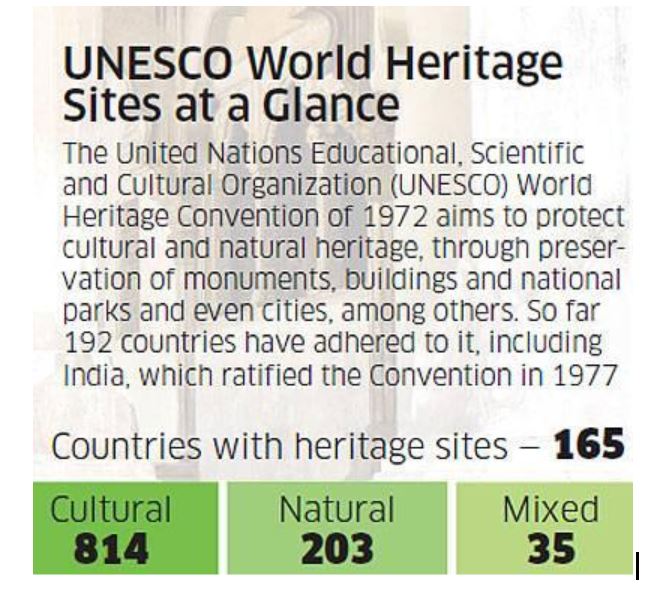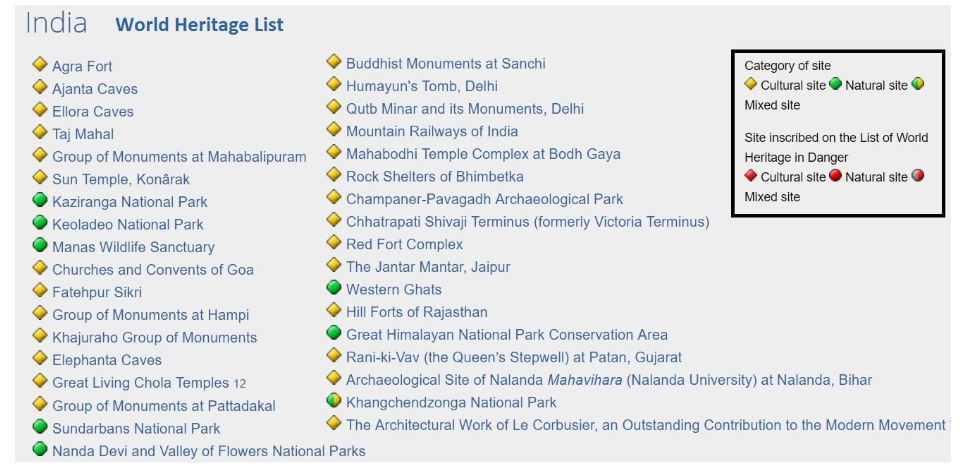Introduction:
Heritage is our legacy from the past, what we live with today, and what we pass on to future generations. Our cultural and natural heritage are both irreplaceable sources of life and inspiration.
The United Nations Educational, Scientific and Cultural Organization (UNESCO) seeks to encourage the identification, protection and preservation of cultural and natural heritage around the world considered to be of outstanding value to humanity. This is embodied in an international treaty called the Convention concerning the Protection of the World Cultural and Natural Heritage , adopted by UNESCO in 1972.
UNESCO’s World Heritage mission is to
- Encourage countries to sign the World Heritage Convention and to ensure the protection of their natural and cultural heritage;
- Encourage States Parties to the Convention to nominate sites within their national territory for inclusion on the World Heritage List;
- Encourage States Parties to establish management plans and set up reporting systems on the state of conservation of their World Heritage sites;
- Help States Parties safeguard World Heritage properties by providing technical assistance and professional training;
- Provide emergency assistance for World Heritage sites in immediate danger;
- Support States Parties’ public awareness-building activities for World Heritage conservation;
- Encourage participation of the local population in the preservation of their cultural and natural heritage;
- Encourage international cooperation in the conservation of our world’s cultural and natural heritage.
The Criteria for Selection
To be included on the World Heritage List, sites must be of outstanding universal value and meet at least one out of ten selection criteria.
The World Heritage Committee, the main body in charge of the implementation of the Convention, has developed precise criteria for the inscription of properties on the World Heritage List and for the provision of international assistance under the World Heritage Fund.
Selection criteria
(i) to represent a masterpiece of human creative genius;
(ii) to exhibit an important interchange of human values, over a span of time or within a cultural area of the world, on developments in architecture or technology, monumental arts, town-planning or landscape design;
(iii) to bear a unique or at least exceptional testimony to a cultural tradition or to a civilization which is living or which has disappeared;
(iv) to be an outstanding example of a type of building, architectural or technological ensemble or landscape which illustrates (a) significant stage(s) in human history;
(v) to be an outstanding example of a traditional human settlement, land-use, or sea-use which is representative of a culture (or cultures), or human interaction with the environment especially when it has become vulnerable under the impact of irreversible change;
(vi) to be directly or tangibly associated with events or living traditions, with ideas, or with beliefs, with artistic and literary works of outstanding universal significance. (The Committee considers that this criterion should preferably be used in conjunction with other criteria);
(vii) to contain superlative natural phenomena or areas of exceptional natural beauty and aesthetic importance;
(viii) to be outstanding examples representing major stages of earth’s history, including the record of life, significant on-going geological processes in the development of landforms, or significant geomorphic or physiographic features;
(ix) to be outstanding examples representing significant on-going ecological and biological processes in the evolution and development of terrestrial, fresh water, coastal and marine ecosystems and communities of plants and animals;
(x) to contain the most important and significant natural habitats for in-situ conservation of biological diversity, including those containing threatened species of outstanding universal value from the point of view of science or conservation.
World Heritage Convention of 1972
- The World Heritage Convention of 1972, adhered to by 192 countries, aims to protect cultural and natural heritage across the world.
- There are presently 1,052 World Heritage sites in 165 countries, of which 814 are cultural sites, 203 natural and 35 mixed; 55 more properties are on the “in danger” list.
- The WHC, however, has received flak for its bias toward Europe and North America, with these two regions being home to nearly half of all World Heritage sites.
India’s World Heritage Sites
India, which ratified the Convention in 1977, has 27 cultural World Heritage sites, seven natural sites and one mixed site. Among the cultural properties are the Taj Mahal, the monuments of Hampi, the churches and convents of Goa, Jaipur’s Jantar Mantar and the Mountain Railways of India, which include the Darjeeling, Nilgiri, and Kalka-Shimla railway networks.
Natural sites include the Sundarbans in West Bengal, the Kaziranga and Manas National Parks in Assam, and the Western Ghats. Sikkim’s Khangchendzonga National Park, which was included this year, is the sole mixed site. While there are four times as many cultural sites in India as natural, the latter are much larger in area. India has the sixth largest number of World Heritage sites. Italy is on top with 51 sites.
Connecting the dots:
- Does UNESCO inscription play a significant role in tourism destinations performance? Also discuss the UNESCO’s role in relation to protecting the world heritage site.
Source:- IAS Baba

 Connecting the dots:
Connecting the dots:


Comments
Post a Comment